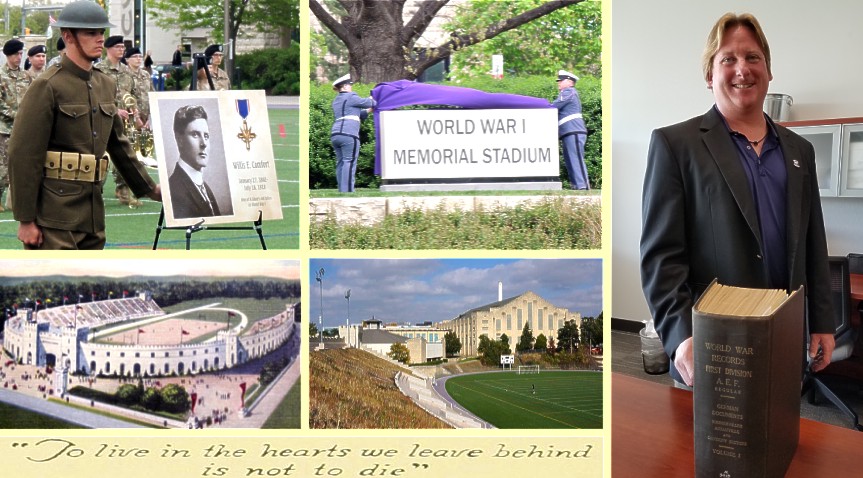Kansas Snapshots by Gloria Freeland - April 28, 2017
A story 100 years in the making
The afternoon was cool, cloudy and breezy, and the forecast called for rain. But the weather didn’t dampen the spirits of
those who were in the stands of Kansas State University’s Memorial Stadium.
We had gathered for the dedication ceremony of the stadium, built to honor the 48 K-Staters who were killed in World War I.
That war - called “The Great War” and “The War to End All War” - began in 1914 in Europe. Only reluctantly did the U.S.
enter three years later - in April 1917. President Woodrow Wilson declared that “the world must be made safe for democracy.”
The story of the dedication is a circuitous one. Students at Kansas State Agricultural College (KSAC) - as K-State
was then known - raised money in the 1920s to build a stadium to honor their fellow K-Staters who were killed. The original
plan called for a horseshoe-shaped entrance on the south end to connect the west and east stands. But the Great Depression,
World War II and other circumstances meant it was never finished.
It was used for football games until 1967. After the new stadium was built, Memorial Stadium was used for lacrosse,
soccer, rugby, fund-raising walks and numerous other activities. A few years ago, there was talk of tearing
it down to build a parking garage.
But instead the decision was made to rejuvenate it. Now, the east side area under the stands holds the Berney Family
Welcome Center and Career Center. The corresponding area under the west stands holds the Purple Masque Theatre.
K-State’s Alumni Center is to the south, where the original gateway was planned.
Yet as time passed, the reason why it was built was largely lost and the men it was intended to honor were mostly
forgotten.
But through the work of many people over the last few years, the stadium was officially dedicated one week ago - 100 years
after the U.S. entered World War I.
A bagpiper played “Amazing Grace” as a soldier dressed in a “Doughboy” uniform stood at attention next to a photo of Capt.
Willis E. Comfort, one of the 48 K-Staters killed. Fort Riley’s color guard marched onto the field to present the colors.
K-State President and retired Air Force Gen. Richard Myers and others spoke at the event.
One of the most eloquent and passionate speakers was Jed Dunham, a 1996 K-State graduate. Dunham is an avid lacrosse
player, who became interested in the stadium’s history during a 2014 visit. He saw a plaque with the 48 names on the southern
tower of the stadium’s east stands. He took a photo of the plaque and later tried to find out about the men, but was
surprised when nearly nothing came up during various internet searches.
He then turned to the 1919 and later editions of the KSAC Royal Purple yearbook. From there, his search widened to
include primary source documents. One was a set of multiple volumes of “German World War Records” that had been translated
into English. It included detailed maps of trenches, information about battles, the weapons used and where people
died.
I first met Jed a year ago, when husband Art and I were deep into our own research about Riley Countians killed in the
Second World War. I met Jed at a local coffee shop and we talked about his research.
He introduced me to Capt. Willis E. Comfort, who served with the 16th Infantry Regiment, 1st Division, American
Expeditionary Forces. He was killed near Soissons, France on July 18, 1918 and awarded the Distinguished Service Cross
posthumously. Eddie Wells, a KSAC varsity basketball and football player, died at the Battle of Saint-Mihiel on Sept. 12,
1918. The American Legion in Manhattan is named for two others: Clede R. Keller and Willis L. Pearce. Howard Wood served in
the Marine Corps 2nd Division and died at Belleau Woods, near Château-Thierry, France on June 23, 1918. The battlefield is
now the Aisne-Marne American Cemetery and Memorial and Wood’s remains are in it, marked by a
white marble cross.
Jed has made many presentations, such as the one at the dedication. His passion is obvious. He is quoted on the
website of the United States World War I Centennial Commission:
The 48 Fallen tell an amazing story. One was an athletic hero and campus celebrity before he went to war. His war was
followed by many through letters and the stories published in the college paper. When he was killed it struck the entire
community with a deep blow.
Another was a founding member of the First Division and his story gives us the story of the Big Red One [It is considered
the starting point of the modern U.S. Army.] ...
... One’s experience as a large animal veterinarian shows us what it was like to tend to the animals of the Great War
while another gives us an insight of how young men became pilots in an era before flight became standard ...
I can go on. What the 48 Fallen have given us is a national treasure. They have a story to tell and it feels as though
they are reaching from beyond the grave to pull our sleeve and share with us a part of our past which we have forgotten.
For much of the past 100 years, who these men were, the sacrifices they made and the reason the stadium had been built
were largely forgotten. But thanks to the efforts of people such as Jed, retired Lt. Col. Art DeGroat, director of
K-State’s Office of Military and Veterans Affairs, area veterans and others, new life has been breathed into the
stories of the 48 and the stadium made to honor them.
